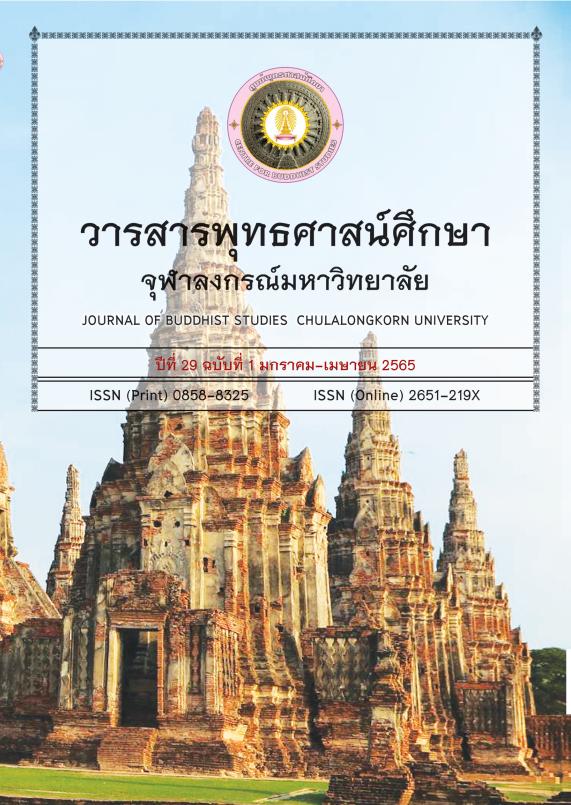Is Drinking Non-Alcoholic Malt Beverage by a Monk in Violation of the Discipline?
Keywords:
Surā, Meraya/Maireya, Non-Alcoholic Malt beverage, Non-alcoholic beerAbstract
This article seeks to examine whether non-alcoholic malt beverages, also commonly known as "non-alcoholic beer", should be considered an intoxicating drink, and if a monk consumes it, would it be in violation of the Discipline? In early 2019 C.E., advertisements, news presentations, and invitations to sample a non-alcoholic malt beverage of a certain brand during work, exercise, or even while operating vehicles were rampant. It was claimed that the beverage does not cause intoxication.
The research is divided into 3 parts: 1) studying information on different types of intoxicating beverages in Ancient India, an era contemporaneous with the time that Buddhism discussed the prohibitionof monks from consuming alcoholic beverages in Surāpānavagga; 2) analyzing the text of the Vinaya that pertains to the consumption of intoxicating beverages; and 3) examining relevant law articles in the Royal Thai Government Gazette - Excise Act B.E. 2017
The study found that the production process of non-alcoholic malt beverages is similar to that of rice-liquor in the Ancient Indian tradition. Today, fermented alcoholic beverage made from rice is called "beer". The Excise Act does not categorize non-alcoholic malt beverages as harmful to the human body or as impairing conscience since they contain no alcohol or less than 0.5 degrees of it. Yet the Vinaya Pitaka does not use intoxication but material as the criterion for offence. Therefore, if a monk consumes a non-alcoholic beverage, even a small drop at the tip of a grass leaf, thinking or suspecting that it may be intoxicating, he is considered to be in violation of the disciplinary rule and must be penalized.
Downloads
References
กองพัฒนาศักยภาพผู้บริโภค สำนักงานคณะกรรมการอาหารและยา. (2562). อย. ชี้ชัด เครื่องดื่มไม่มีแอลกอฮอล์ห้ามโฆษณาเชื่อมโยงถึงเบียร์หรือเครื่องดื่มแอลกอฮอล์. สืบค้นจาก http://pca.fda.moph.go.th/public_media_detail.php?id=2&cat=50&content_id=1591.
กนกรัตน์ ทวีสุข และกรองกาญจน์ แก้วชัง. (2559). แนวคิดแรงจูงใจตามหลักพระพุทธศาสนา. วารสารครุศาสตร์ปริทรรศน์ คณะครุศาสตร์ มหาวิทยาลัยมหาจุฬาลงกรณมหาวิทยาลัย, 3(3), 147-156.
ชานป์วิชช์ ทัดแก้ว. (2563). วัฒนธรรม "การดื่ม" แบบอินเดียโบราณ. สืบค้นจาก https://www.facebook.com/southasianlanguageschula/photos/a.661620740566189/2895859160475658/?type=3&eid=ARCnAdcckN0spQ_GPRemn-CXbY9faDcjE-TRgg1EIw4gA8pbrhpSYkLIBE_ QPq9d8ZEwyU6M1ieEjPmb&ifg=1.
นงนุช ใจชื่น, โศภิต นาสืบ, กมลพัฒน์ มากแจ้ง, สุรศักดิ์ ไชยสงค์ และชุติมา อรรคลีพันธุ์. (2561). กฎหมายควบคุมเครื่องดื่มที่มีปริมาณแอลกอฮอล์ไม่เกิน 0.5 ดีกรีของประเทศไทยและต่างประเทศ. วารสารวิจัยระบบสาธารณสุข, 12(4), 525-545.
บุณฑริกา บุญโญ. (2558). กฎหมายมรดกในคัมภีร์ธรรมศาสตร์กับกฎหมายตราสามดวง (ปริญญามหาบัณฑิต จุฬาลงกรณ์มหาวิทยาลัย).
ปริญญพันธุ์ เพชรจรัส. (2557). เอกสารประกอบการสอน วิชาเทคโนโลยีชีวภาพอุตสาหกรรม. สืบค้นจาก http://portal5.udru.ac.th/ebook/pdf/upload/17FFcDL1Y5h69LI55FjO.pdf.
มหามกุฎราชวิทยาลัย. (2555). พระไตรปิฎกและอรรถกถาแปล ชุด 91 เล่ม. พิมพ์ครั้งที่ 6. กรุงเทพมหานคร: มหามกุฎราชวิทยาลัย ในพระบรมราชูปถัมภ์.
ราชกิจจานุเบกษา. (2562). พระราชบัญญัติ ภาษีสรรพสามิต พ.ศ. 2560. สืบค้นจาก https://www.excise.go.th/cs/groups/public/documents/document/dwnt/mjcz/~edisp/uatucm273088.pdf.
วิทยา ศักยาภินันท์. (2554). คุรุกุล: สถาบันการศึกษาของอินเดียสมัยโบราณ. วารสารมนุษยศาสตร์ คณะมนุษยศาสตร์ มหาวิทยาลัยเกษตรศาสตร์, 18(2), 1-16.
พิมพ์เพ็ญ พรเฉลิมพงศ์ และนิธิยา รัตนาปนนท์. (2564). Fermentation / การหมัก. สืบค้นจาก http://www.foodnetworksolution.com/wiki/word/0316/fermentation-การหมัก.
พิมพ์เพ็ญ พรเฉลิมพงศ์ และนิธิยา รัตนาปนนท์. (2564). Pickle / อาหารดอง. สืบค้นจาก http://www.foodnetworksolution.com/wiki/word/1481/pickle.
พระมหาสมชาย ฐานวุฑฺโฒ, วิธีการใหม่ในการศึกษากำเนิดพระไตรปิฎก. ม.ป.พ., 2552.
พระมหาสมชาย ฐานวุฑฺโฒ. “สิกขาบทในพระปาติโมกข์เกิดขึ้นเมื่อใด.” วารสารธรรมธารา, 1(1), 13-54, สืบค้นจาก https://so01.tci-thaijo.org/index.php/dhammadhara/article/view/160687/115864.
ภาควิชานิติเวชศาสตร์ คณะแพทย์ศาสตร์ศิริราชพยาบาล มหาวิทยาลัยมหิดล. (2563). ดื่มเครื่องดื่มแอลกอฮอล์ขับรถโดยไม่ผิดกฎหมาย. สืบค้นจาก https://www.si.mahidol.ac.th/sidoctor/e-pl/articledetail.asp?id=141&fbclid=IwAR03A-hHI0CbIFb08cRqgCFuhRRfliYHYkCNP 5ErpMJ3FYtCAWg_gllS_tU.
สุทิน บุญหล้า. (2559). การประยุกต์ใช้โครงข่ายประสาทเทียมในการตรวจสอบคุณภาพของกระบวนการหมักเบียร์ในครัวเรือน (ปริญญามหาบัณฑิต มหาวิทยาลัยธรรมศาสตร์).
สำนักงานสถิติแห่งชาติ. (2562). สำนักงานสถิติฯ เผยผลสำรวจพฤติกรรมการดื่มสุรา พ.ศ. 2560. สืบค้นจาก http://www.nso.go.th/sites/2014/DocLib14/News/2561/08-61/N30-08-61-2.pdf.
ศูนย์บริการวิชาการแห่งจุฬาลงกรณ์มหาวิทยาลัย. (ม.ป.ป.). การศึกษาสำรวจโรงงานสุรากลั่น. สืบค้นจาก http://www2.diw.go.th/sura/บำบัดน้ำเสีย/รายงานฉบับสมบูรณ์/บทที่%203_11%20sep%2006.pdf.
ศูนย์เรียนรู้สุขภาวะ สำนักงานกองทุนสนับสนุนการสร้างเสริมสุขภาพ. (2563). สุราคือยาเสพติด ทุกวันที่ดื่มมีโอกาสตายมากกว่ารอด ดับชีวิต ดับฝัน ดับวันพรุ่งนี้. สืบค้นจาก https://dol.thaihealth.or.th/resourcecenter/sites/default/files/documents/final_enuuehaaaanprakbsuue_suraakhuueyaaesphtid.pdf.
อุราวดี แก้วละเอียด. (ม.ป.ป.). ศาสตร์และศิลป์แห่งไวน์. วารสารนักบริหาร, 27(1), 73-78. สืบค้นจาก https://www.bu.ac.th/knowledgecenter/executive_journal/jan_mar_07/pdf/Excutive_75-80.pdf.
อรัณย์ หนองพล. (2562). ถอดสูตรเครื่องดื่มมอลต์สกัดแอลกอฮอล์ออก ใครดื่ม ดื่มอย่างไร และโฆษณาอย่างไรให้ถูกกฎหมาย?. สืบค้นจาก https://thestandard.co/zero-alcohol/.
Amki Green. (2013). แอลกอฮอล์อยู่ในร่างกายได้นานเท่าไร. สืบค้นจาก https://www.trueplookpanya.com/knowledge/content/74463/-blo-scihea-sci-#:~:text=แอลกอฮอล์%20(Alcohol)%20เป็นสารกด,เหล่านี้ออกจากร่างกาย.
Anirut.J. (2562). นักดื่มฟังไว้ ปริมาณแอลกอฮอล์ในร่างกายเท่าไหร่ถึงอาจทำให้คุณถึงตายได้, สืบค้นจาก https://www.smartsme.co.th/content/226577.
GeneusDNA. (2020). ตับกำจัดแอลกอฮอล์ไม่ได้ อันตรายกว่าที่คิด! พันธุกรรม คือ สาเหตุสำคัญ. สืบค้นจาก https://www.blog.geneusdna.com/post/alcohol-dna.
MarketingOops!. (2562). เปิดแผน Heineken 0.0 Barcade ชิงตลาดเบียร์ไร้แอลกอฮอล์เจ้าแรกในไทย. สืบค้นจาก https://www.marketingoops.com/news/brand-move/heineken-0-0-barcade/.
Voice Online. (2562). 'เบียร์ไร้แอลกอฮอล์' ทางเลือกใหม่ของคนรักสุขภาพ ที่กำลังเติบโตไปทั่วโลก. สืบค้นจาก https://voicetv.co.th/read/iLW7tAtpO.
Anthony Kennedy Warder. (1994). Indian Kavya Literature, Volume 4. Shri Jainendra press: India.
E. Hosseini, M. Kadivar, and M. Shahedi. (2002). Physicochemical Properties and Storability of Non-alcoholic Malt Drinks Prepared from Oat and Barley Malts. Journal of Agricultural Science and Technology, 14(1), 173-182.
E. Lamotte. (1988). History of Indian Buddhism. Peeters Press: Louvain-Paris.
Ganga Prasad Yadava. (1981). Dhanapāla and His Times: A Socio-cultural Study Based Upon His Works. Concept Publishing Company: New Delhi.
Kautilya. (1967). Arthashastra. (R. Shamasastry Trans). Mysore Publishing and Printing House: India.
Kayu Okutsu, Arisa Kurotani, Yohei Sasaki and Masayuki Mikage. (2013). Differences between the chemical constituents of tincture and Arishta, and ayurvedic herbal liquor prepared from ginger, long pepper and jujube. J.Trad.Med, 30(5/6), 206-214.
Koyel Koley. (2018). Hinduism and Abortion: A Traditional View. Inter- national Journal of Creative Research Thoughts, 6(2), 92-98.
K.T. Achaya. (1991). Alcoholic Fermentation and its products in Ancient India. Indian Journal of History of Science, 26(2), 123-129.
Madhavi Kolhatkar. (1987). The Method of Preparing Surā According to the Vedic Texts. Bulletin of the Deccan College Post-Graduate and Research Institute, 46, 41-45.
Mornier Williams. (1986). A Sanskrit-English Dictionary. Shri Jainendra Press: India. Om Prakash. (2004). Cultural History of India. New Age International: New Delhi.
T.W. Rhys Davids and William Stede. (1921-1925). The Pali Text Society's Pali-English Dictionary. The Pali Text Society.
Pandurang Vaman Kane. (1941). History of Dharmaśāstra. Bhandarkar Oriental Research Institute: Poona.
Saji Joseph and Hemeletha K. (2020). Alcohol and Alcoholism in India: A Historical Review. International Journal of Science and Healthcare Research, 5(4), 343-354.
S. Sekar. (2007). Traditional alcoholic beverages from Ayurveda and their role on human health. Indian Journal of Traditional Knowledge, 6(1), 144-149.
Downloads
Published
How to Cite
Issue
Section
License
Copyright (c) 2022 Chulalongkorn University Centre for Buddhist Studies

This work is licensed under a Creative Commons Attribution-NonCommercial-NoDerivatives 4.0 International License.
บทความที่ได้รับการตีพิมพ์เป็นลิขสิทธิ์ของศูนย์พุทธศาสน์ จุฬาลงกรณ์มหาวิทยาลัย
ข้อความที่ปรากฏในบทความแต่ละเรื่องในวารสารวิชาการเล่มนี้เป็นความคิดเห็นส่วนตัวของผู้เขียนแต่ละท่านไม่เกี่ยวข้องกับศูนย์พุทธศาสน์ จุฬาลงกรณ์มหาวิทยาลัย และคณาจารย์ท่านอื่นๆในมหาวิทยาลัยฯ แต่อย่างใด ความรับผิดชอบองค์ประกอบทั้งหมดของบทความแต่ละเรื่องเป็นของผู้เขียนแต่ละท่าน หากมีความผิดพลาดใดๆ ผู้เขียนแต่ละท่านจะรับผิดชอบบทความของตนเองแต่ผู้เดียว






